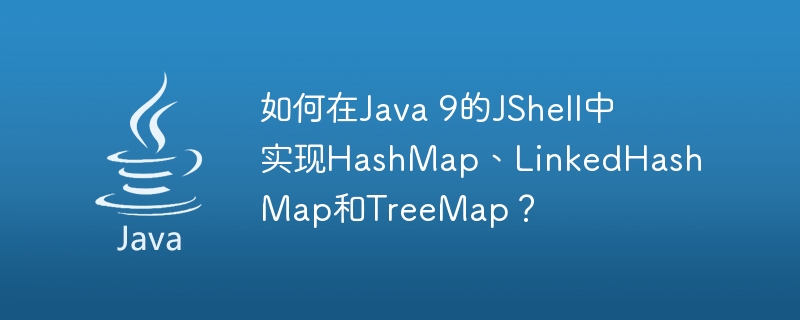How to implement HashMap, LinkedHashMap and TreeMap in JShell in Java 9?

JShell是Java 9中引入的命令行提示工具,也称为REPL 评估简单语句、执行它并立即打印输出的工具。
Map 接口指定一个契约,以键/值的形式实现元素集合对。实现Map接口的Java集合类有HashMap、LinkedHashMap和TreeMap。
在下面的代码片段中,HashMap的元素不保证以插入顺序或键的排序顺序存储。
Snippet-1
<strong>jshell> HashMap<String, Integer> hashMap = new HashMap<>();
hashMap ==> {}
jshell> hashMap.put("Adithya", 101);
$2 ==> null
jshell> hashMap.put("Jai", 102);
$3 ==> null
jshell> hashMap.put("Chaitanya", 103);
$4 ==> null
jshell> hashMap.put("Ravi", 104);
$5 ==> null
jshell> hashMap
hashMap ==> {Chaitanya=103, Jai=102, Ravi=104, Adithya=101}</strong>在下面的代码片段中,LinkedHashMap的元素已存储在插入中订单。
Snippet-2
<strong>jshell> LinkedHashMap<String, Integer> linkedHashMap = new LinkedHashMap<>();
linkedHashMap ==> {}
jshell> linkedHashMap.put("Raja", 101);
$8 ==> null
jshell> linkedHashMap.put("Adithya", 102);
$9 ==> null
jshell> linkedHashMap.put("Surya", 103);
$10 ==> null
jshell> linkedHashMap.put("Vamsi", 104);
$11 ==> null
jshell> linkedHashMap
linkedHashMap ==> {Raja=101, Adithya=102, Surya=103, Vamsi=104}</strong>在下面的代码片段中,TreeMap 的元素已按键的自然排序顺序存储。
代码片段-3
<strong>jshell> TreeMap<String, Integer> treeMap = new TreeMap<>();
treeMap ==> {}
jshell> treeMap.put("Raj", 101);
$14 ==> null
jshell> treeMap.put("Pavan", 102);
$15 ==> null
jshell> treeMap.put("Arjun", 103);
$16 ==> null
jshell> treeMap.put("Manoj", 104);
$17 ==> null
jshell> treeMap
treeMap ==> {Arjun=103, Manoj=104, Pavan=102, Raj=101}</strong>The above is the detailed content of How to implement HashMap, LinkedHashMap and TreeMap in JShell in Java 9?. For more information, please follow other related articles on the PHP Chinese website!

Hot AI Tools

Undress AI Tool
Undress images for free

Undresser.AI Undress
AI-powered app for creating realistic nude photos

AI Clothes Remover
Online AI tool for removing clothes from photos.

Clothoff.io
AI clothes remover

Video Face Swap
Swap faces in any video effortlessly with our completely free AI face swap tool!

Hot Article

Hot Tools

Notepad++7.3.1
Easy-to-use and free code editor

SublimeText3 Chinese version
Chinese version, very easy to use

Zend Studio 13.0.1
Powerful PHP integrated development environment

Dreamweaver CS6
Visual web development tools

SublimeText3 Mac version
God-level code editing software (SublimeText3)
 Comparing Java Frameworks: Spring Boot vs Quarkus vs Micronaut
Aug 04, 2025 pm 12:48 PM
Comparing Java Frameworks: Spring Boot vs Quarkus vs Micronaut
Aug 04, 2025 pm 12:48 PM
Pre-formanceTartuptimeMoryusage, Quarkusandmicronautleadduetocompile-Timeprocessingandgraalvsupport, Withquarkusoftenperforminglightbetterine ServerLess scenarios.2.Thyvelopecosyste,
 What is a deadlock in Java and how can you prevent it?
Aug 23, 2025 pm 12:55 PM
What is a deadlock in Java and how can you prevent it?
Aug 23, 2025 pm 12:55 PM
AdeadlockinJavaoccurswhentwoormorethreadsareblockedforever,eachwaitingforaresourceheldbytheother,typicallyduetocircularwaitcausedbyinconsistentlockordering;thiscanbepreventedbybreakingoneofthefournecessaryconditions—mutualexclusion,holdandwait,nopree
 How to join an array of strings in Java?
Aug 04, 2025 pm 12:55 PM
How to join an array of strings in Java?
Aug 04, 2025 pm 12:55 PM
Using String.join() (Java8) is the easiest recommended method for connecting string arrays, just specify the separator directly; 2. For old versions of Java or when more control is needed, you can use StringBuilder to manually traverse and splice; 3. StringJoiner is suitable for scenarios that require more flexible formats such as prefixes and suffixes; 4. Using Arrays.stream() combined with Collectors.joining() is suitable for filtering or converting the array before joining; To sum up, if Java8 and above is used, the String.join() method should be preferred in most cases, which is concise and easy to read, but for complex logic, it is recommended.
 How to implement a simple TCP client in Java?
Aug 08, 2025 pm 03:56 PM
How to implement a simple TCP client in Java?
Aug 08, 2025 pm 03:56 PM
Importjava.ioandjava.net.SocketforI/Oandsocketcommunication.2.CreateaSocketobjecttoconnecttotheserverusinghostnameandport.3.UsePrintWritertosenddataviaoutputstreamandBufferedReadertoreadserverresponsesfrominputstream.4.Usetry-with-resourcestoautomati
 How to compare two strings in Java?
Aug 04, 2025 am 11:03 AM
How to compare two strings in Java?
Aug 04, 2025 am 11:03 AM
Use the .equals() method to compare string content, because == only compare object references rather than content; 1. Use .equals() to compare string values equally; 2. Use .equalsIgnoreCase() to compare case ignoring; 3. Use .compareTo() to compare strings in dictionary order, returning 0, negative or positive numbers; 4. Use .compareToIgnoreCase() to compare case ignoring; 5. Use Objects.equals() or safe call method to process null strings to avoid null pointer exceptions. In short, you should avoid using == for string content comparisons unless it is explicitly necessary to check whether the object is in phase.
 How to send and receive messages over a WebSocket in Java
Aug 16, 2025 am 10:36 AM
How to send and receive messages over a WebSocket in Java
Aug 16, 2025 am 10:36 AM
Create a WebSocket server endpoint to define the path using @ServerEndpoint, and handle connections, message reception, closing and errors through @OnOpen, @OnMessage, @OnClose and @OnError; 2. Ensure that javax.websocket-api dependencies are introduced during deployment and automatically registered by the container; 3. The Java client obtains WebSocketContainer through the ContainerProvider, calls connectToServer to connect to the server, and receives messages using @ClientEndpoint annotation class; 4. Use the Session getBasicRe
 Correct posture for handling non-UTF-8 request encoding in Spring Boot application
Aug 15, 2025 pm 12:30 PM
Correct posture for handling non-UTF-8 request encoding in Spring Boot application
Aug 15, 2025 pm 12:30 PM
This article discusses the mechanism and common misunderstandings of Spring Boot applications for handling non-UTF-8 request encoding. The core lies in understanding the importance of the charset parameter in the HTTP Content-Type header, as well as the default character set processing flow of Spring Boot. By analyzing the garbled code caused by wrong testing methods, the article guides readers how to correctly simulate and test requests for different encodings, and explains that Spring Boot usually does not require complex configurations to achieve compatibility under the premise that the client correctly declares encoding.
 Exploring Common Java Design Patterns with Examples
Aug 17, 2025 am 11:54 AM
Exploring Common Java Design Patterns with Examples
Aug 17, 2025 am 11:54 AM
The Java design pattern is a reusable solution to common software design problems. 1. The Singleton mode ensures that there is only one instance of a class, which is suitable for database connection pooling or configuration management; 2. The Factory mode decouples object creation, and objects such as payment methods are generated through factory classes; 3. The Observer mode automatically notifies dependent objects, suitable for event-driven systems such as weather updates; 4. The dynamic switching algorithm of Strategy mode such as sorting strategies improves code flexibility. These patterns improve code maintainability and scalability but should avoid overuse.







